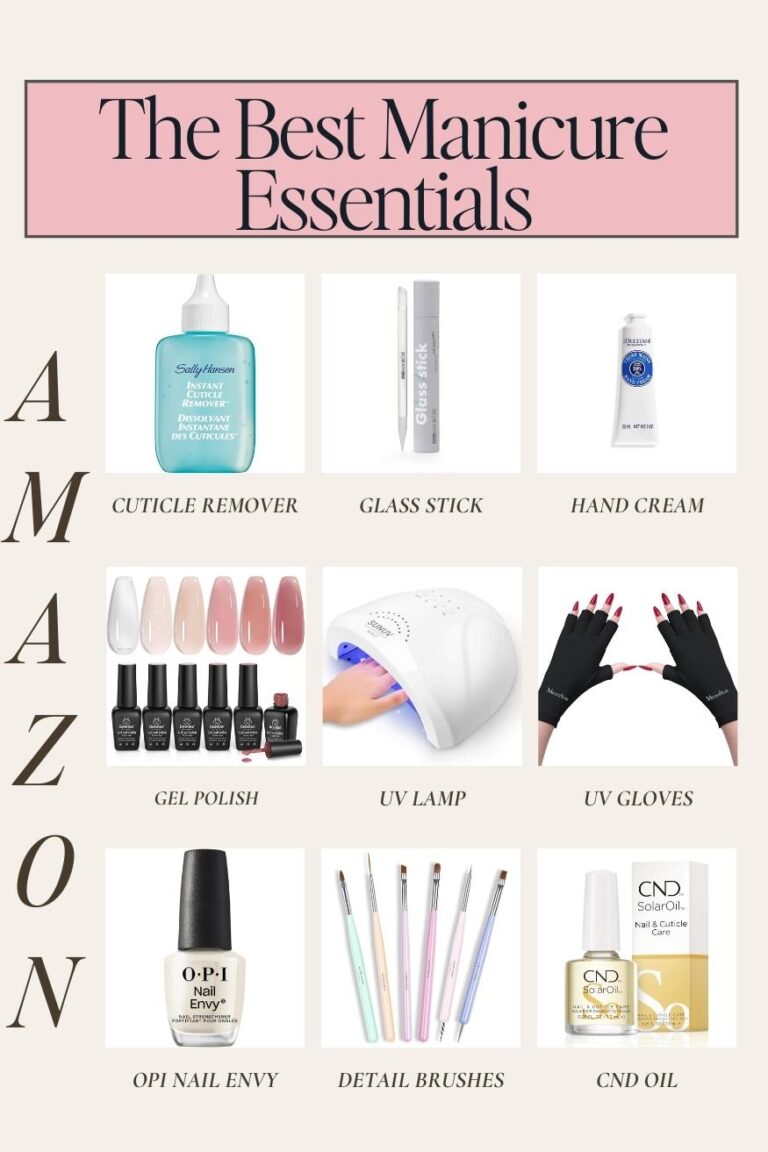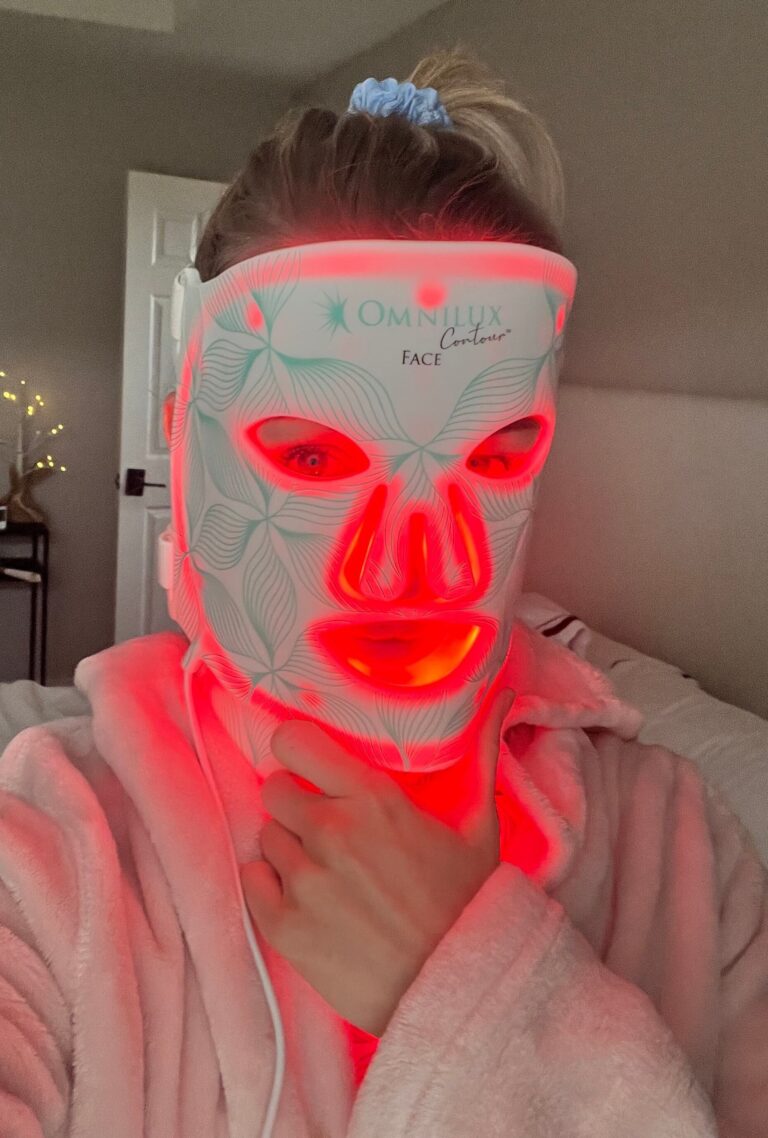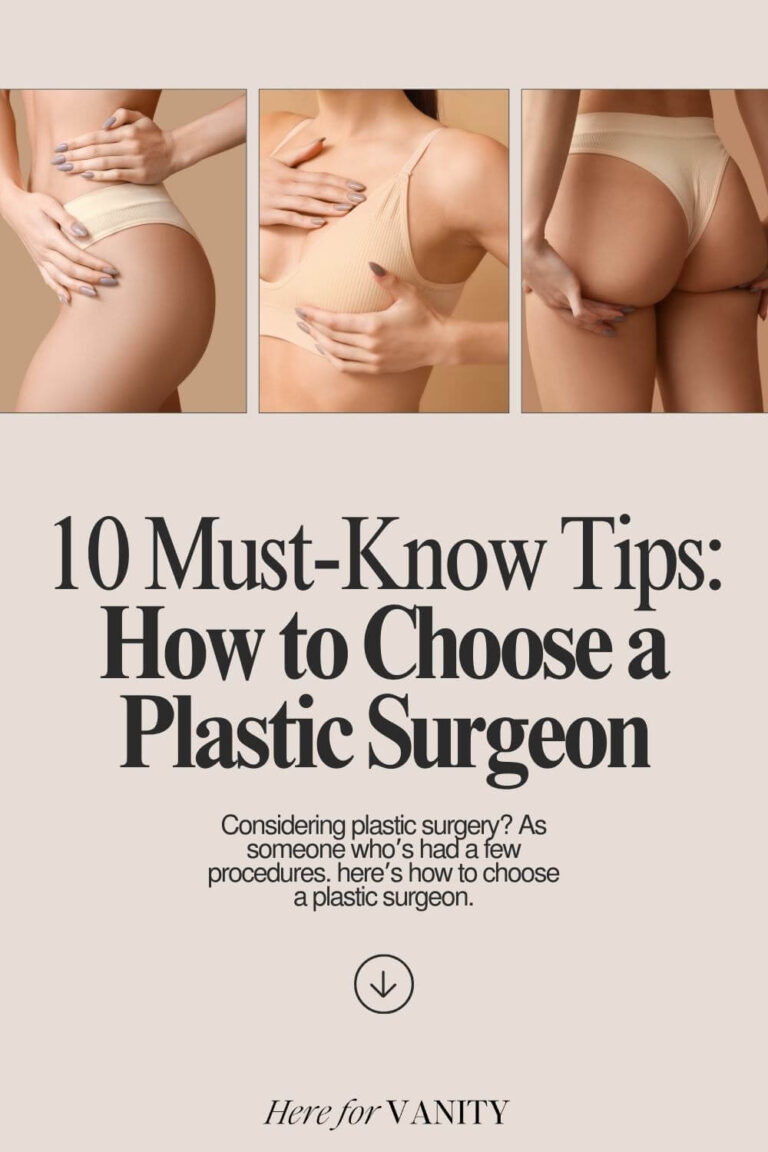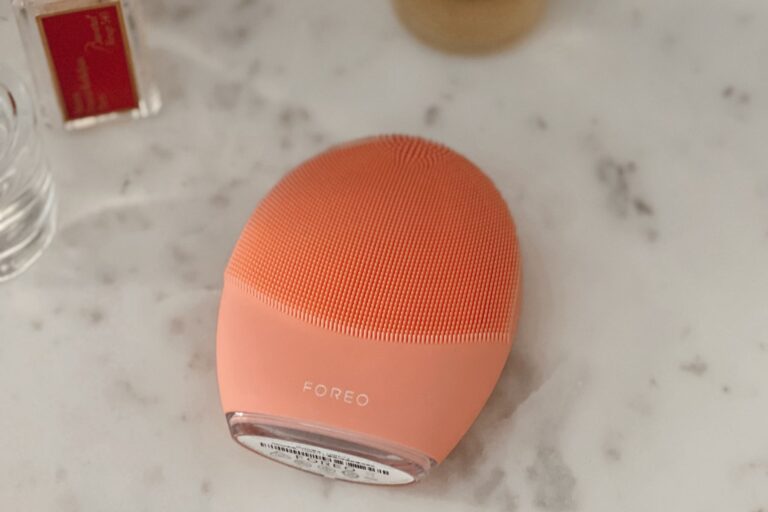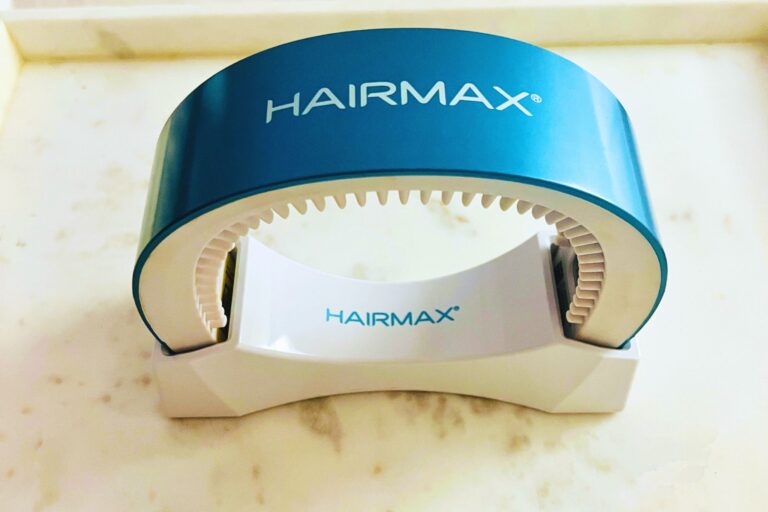The Ultimate Body Detox: How to Dry Brush for Lymphatic Drainage
Need a full-body detox? Look no further. We’ll discuss all the benefits of dry brushing and how to dry brush for lymphatic drainage.
PIN for later:

What is Dry Brushing?
Dry brushing isn’t just a new wellness trend – it’s an ancient ayurvedic medicine practice that uses a natural-bristled brush to gently massage the skin in upward strokes, typically before showering.
This ancient practice not only exfoliates the skin but also stimulates the lymphatic system, our body’s natural detoxification mechanism.
In today’s world filled with toxins and stress, dry brushing naturally increases blood circulation, detoxes your body, and helps you look and feel rejuvenated.
The results? Improved skin appearance and stronger immune system function.
Benefits of Dry Brushing
Dry brushing has become pretty trendy and a favorite among celebs who can’t stop raving about its benefits.
With these A-list endorsements, dry brushing has become a niche practice and a must-have self-care ritual.
Dry brushing offers many benefits, from exfoliating and reducing cellulite to promoting lymphatic drainage and boosting blood flow and circulation. It’s a simple yet effective way to rejuvenate your skin and enhance overall well-being.
Here are some of the best dry brushing benefits:
Dry Brushing Exfoliates the Skin
Dry brushing involves gently using a firm, natural-bristled brush to sweep over the skin in small circular motions and long strokes.
This action helps slough off dead skin cells, revealing smoother and more radiant skin underneath.
Regular dry brushing can improve the skin’s texture and appearance, leaving it looking and feeling firm and rejuvenated.
Dry Brushing is Relaxing
The repetitive and rhythmic motion of dry brushing can soothe both the body and mind. It provides a gentle massage-like sensation that promotes relaxation and can be a calming addition to any daily routine.
Dry Brushing May Reduce Cellulite
Cellulite occurs when fat deposits push through the connective tissue beneath the skin, creating a dimpled appearance, particularly on the thighs and buttocks.
This can help break down fat deposits and reduce fluid retention, leading to smoother-looking skin over time with consistent use.
Dry Brushing Detoxes the Entire Body
The skin is the body’s largest organ, and the lymphatic system plays a crucial role in the body’s detoxification process, helping remove waste and toxins from the tissues.
Dry brushing stimulates the lymphatic system by promoting the flow of lymph fluid throughout the body. This can help enhance the body’s natural detoxification processes, supporting overall health and well-being.
Regular dry brushing can also leave you feeling lighter, more energized, and refreshed as toxins are flushed out of your system.
Why Do We Need Lymphatic Drainage?
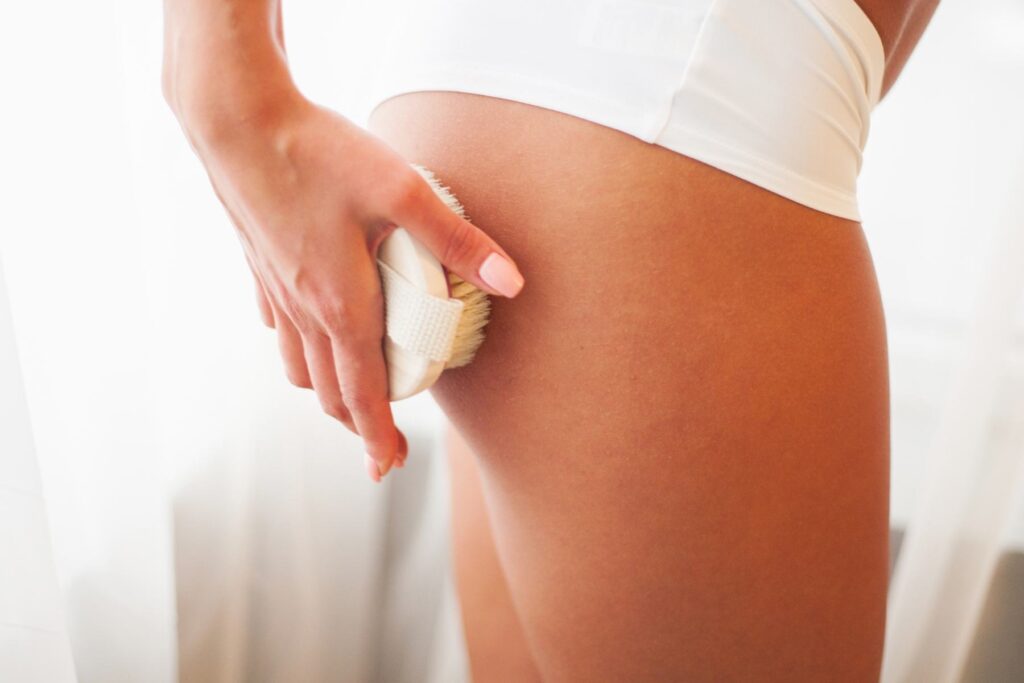
Lymphatic drainage is essential for maintaining our overall health and well-being. Think of the lymphatic system as the body’s natural detoxification and waste removal system.
It helps to eliminate toxins, excess fluids, and waste products from the tissues, keeping our bodies clean and functioning optimally.
Did you know there are between 500 and 700 lymph nodes in the body?
These lymph nodes act as filtration stations, trapping harmful substances like bacteria and viruses. They’re strategically located throughout the body, with clusters in the neck, armpits, groin, chest, abdomen, and pelvis.
They filter lymph fluid, which carries white blood cells, proteins, and other nutrients, removing toxins and waste products.
Have you ever had swollen lymph nodes when coming down with a cold? When your lymph nodes swell, it’s like a red flag signaling that your body’s immune system is hard at work nearby.
Without proper lymphatic drainage, these toxins and waste can build up, leading to inflammation, swelling, and a weakened immune system.
Additionally, the lymphatic system is crucial in transporting immune cells throughout the body, helping defend against infections and illnesses.
By supporting lymphatic drainage through practices like dry brushing, we can help the lymph system promote better circulation, reduce inflammation, and support our body’s natural detoxification processes, ultimately leading to improved overall health.
Doesn’t My Liver Naturally Detox My Body?
Mostly, yes.
The liver and the lymphatic system are both essential for detoxification, but they play different roles and operate in distinct ways.
The liver is the primary organ responsible for detoxification in the body. It metabolizes and eliminates toxins, drugs, and other harmful substances from the bloodstream through a series of enzymatic reactions.
The liver converts these toxins into water-soluble compounds that can be excreted through urine or bile.
On the other hand, the lymphatic system removes cellular waste, dead cells, toxins, and excess fluids from the tissues. Lymph fluid circulates through a network of vessels and is filtered through lymph nodes, where immune cells trap and neutralize harmful substances.
While the liver and the lymphatic system contribute to detoxification, they target different toxins and operate through different mechanisms.
The liver primarily processes toxins absorbed from the digestive tract or produced during metabolic processes. At the same time, the lymphatic system focuses on removing cellular waste and toxins from the interstitial fluid surrounding the body’s cells.
A good dry brushing routine for lymphatic drainage can help eliminate cell debris naturally and encourage detoxification.
How To Dry Brush for Lymphatic Drainage (and Detox)
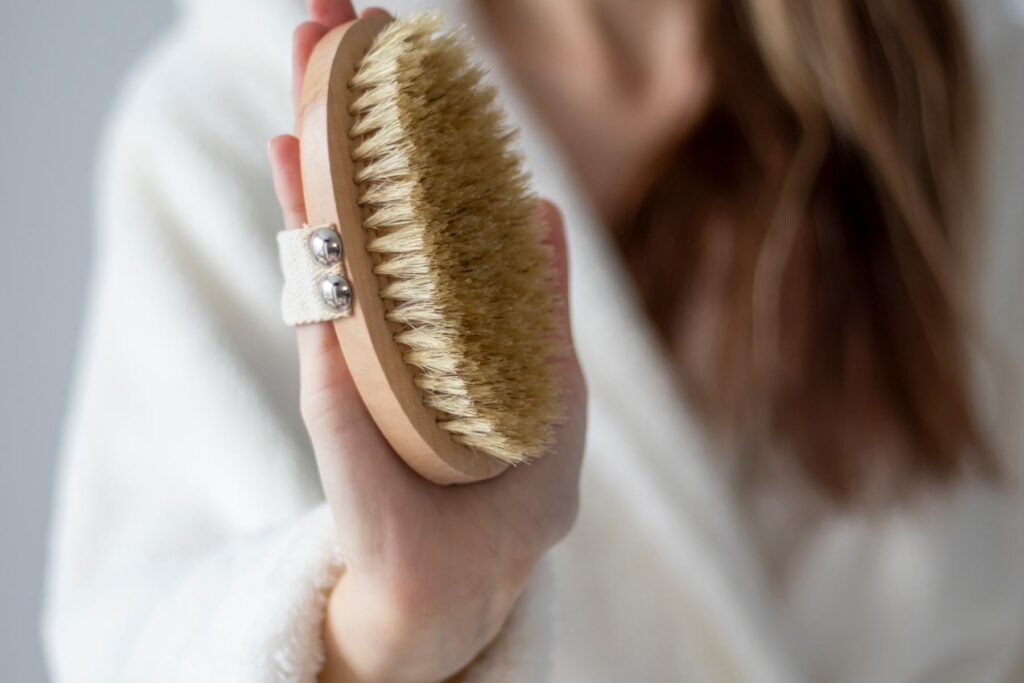
Dry brushing is simple and can be done a few times a week up to daily.
To start, you’ll need a natural bristle brush. Beginning at your feet, use gentle upward strokes towards your heart, gradually working your way up your body. Be sure to cover all areas, including your legs, thighs, torso, arms, and back. Avoid sensitive areas and any broken or irritated skin.
It takes me about 5 minutes each time – sometimes longer if I have the time.
After dry brushing, hop in the shower to rinse off any loosened dead skin cells and toxins. Clean your brush after each use to maintain hygiene. That’s it – a simple yet effective way to support lymphatic drainage and promote healthy, glowing skin.
Step-by-Step Dry Brushing Technique for Lymphatic Drainage
- Choose the Right Brush: Select a high-quality brush with natural fibers. Avoid brushes with synthetic bristles or ones that are too stiff, as they can irritate the skin.
- Begin with Dry Skin: Ensure your skin is completely dry before showering or bathing. This allows the brush to glide smoothly over the skin and maximize its exfoliating and stimulating effects.
- Start at Your Feet: Begin brushing at the top of the feet, using gentle upward strokes towards the direction of your heart and lymph nodes. Brush each area of your skin several times, but avoid sensitive areas or open wounds.
- Move Upward: Gradually work your way up your legs, thighs, and butt, always brushing towards your heart and towards the lymph nodes. Use long, sweeping motions and adjust the pressure so it’s comfortable for you.
- Address Your Torso: Next, move to your upper body and torso, starting at your lower back and brushing upwards towards your chest. Pay special attention to your abdomen, where the lymphatic system is concentrated.
- Don’t Forget Your Arms: Switch to brushing your arms, starting from your hands and working your way up towards your shoulders and collarbone. Again, use gentle strokes and be mindful of any sensitive areas.
- Focus on Your Back: If possible, reach behind your back to brush in upward strokes towards your shoulders. A brush with a long handle is handy here!
- Finish at Your Neck and Chest: Finally, brush the front of your neck and chest area using gentle upward strokes. Skip or use very gentle pressure around delicate areas like the throat and breasts.
- Take a Shower: Once you’ve finished dry brushing, hop in the shower or bath to wash away any loosened dead skin cells and toxins. Follow up with your usual skincare routine to moisturize and nourish your skin.
- Clean Your Brush: After each use, clean your dry brush with soap and water and allow it to dry completely before storing it in a dry place. This helps prevent bacteria growth and ensures your brush stays in good condition for future use.
What are the Risks of Dry Brushing?
While generally safe, dry brushing can pose risks if you’re too rough or have skin conditions.
The main concern is skin irritation, especially for those with sensitive skin or certain skin conditions like eczema or psoriasis.
Too much pressure or a brush with stiff bristles can cause redness, itching, or even small cuts. Additionally, dry brushing over broken or irritated skin can worsen the condition. It’s important to be gentle and avoid excessive pressure.
Of course, if you have underlying health issues like cancer or compromised immunity, contact your doctor before starting dry brushing to ensure it’s safe for you.
Tips For Your Dry Brushing Routine
Here are some helpful tips to enhance your dry brushing routine:
- Choose the Right Brush: Opt for a natural fiber brush and a comfortable handle for easy use. They make body brushes with longer handles or hard-to-reach areas, too. I prefer a handheld one because it’s easier to grip.
- Timing is Key: Dry brush before showering or bathing when your skin is dry to maximize its exfoliating and stimulating effects.
- Gentle Strokes: Use light pressure and gentle strokes to avoid irritation, especially if you have sensitive skin.
- Start from the Bottom: Begin brushing at your feet and working toward your heart, following the direction of lymphatic flow.
- Target Trouble Areas: Focus on areas prone to cellulite or lymphatic congestion, such as thighs, butt, and abdomen.
- Avoid Sensitive Areas: If you have sensitive skin, avoid delicate areas like the face, breasts, and any areas with broken or irritated skin.
- Frequency Matters: Start with 2-3 times a week and adjust based on your skin’s response. Listen to your body and avoid overdoing it.
- Moisturize: Slather on a moisturizer or body oil to hydrate your skin after dry brushing.
- Clean Your Brush: Rinse your dry brush with soap and water after each use and let it air dry completely to prevent bacteria buildup.
- Drink Lots of Water: Encourage further detoxification by drinking lots of water after dry brushing.
- Be Consistent: For best results, incorporate dry brushing into your routine regularly. Consistency is key to seeing benefits.
How to Choose the Best Dry Brush To Use
Not all dry brushes are created equal! I went through cheapy ones before I found a good one that worked for me. For maximum results, get a good brush that doesn’t feel like sandpaper!
- Bristle Type: Look for a brush with natural bristles, preferably made from materials like boar hair or plant fibers. These bristles are gentle on the skin and provide effective exfoliation. Start with a softer brush, especially if you have sensitive skin.
- Brush Size and Shape: A brush with a long handle can make reaching all areas of your body easier, while a smaller brush head may be more maneuverable for detailed brushing.
- Bristle Firmness: Choose a brush with bristles that are firm enough to provide stimulation but not too stiff to cause irritation or discomfort, especially if you have sensitive skin.
- Quality and Durability: Invest in a high-quality, well-made, durable brush. Look for brushes with securely attached bristles and sturdy construction to ensure longevity.
- Personal Preference: Ultimately, the best dry brush for you feels comfortable to use and suits your preferences. Consider factors like brush texture, weight, and design to find the perfect match for your dry brushing routine.
Best Dry Brushes
I really like the Goop Dry Brush and the Kitsch Dry Brush for a super soft vegan brush alternative.
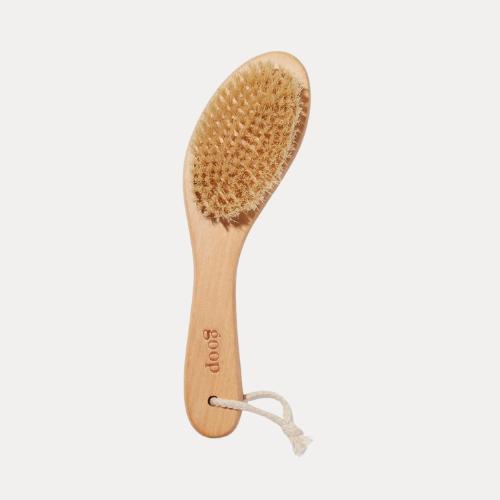

For the full list of recommendations, see: The Best Dry Brushes for Lymphatic Drainage
What Does the Science Say?
Results are mixed in terms of the efficacy of dry brushing. Ultimately, there’s no firm evidence that it works to detox or eliminate cellulite. But many people have dry brush and have seen and felt amazing results.
As someone over 40, I’m willing to try any detox method to give me glowing skin benefits. Plus, it’s simple and easy to incorporate into my self-care routine and makes me feel great.
Related: How to Glow-Up Overnight: A Step-by-Step Guide
Is Dry Brushing Worth the Effort?
Dry brushing offers tons of detox benefits for your skin and overall well-being.
Incorporating this simple yet effective practice into your routine can promote lymphatic drainage, exfoliate dead skin cells, reduce cellulite, and enhance relaxation.
Dry brushing is a low-cost and simple way to boost skin radiance, support your body’s natural detoxification processes, or simply indulge in a moment of self-care.
Remember to choose the right brush, use gentle strokes, and listen to your body’s cues.
Have you tried dry bushing? Let me know your thoughts!

